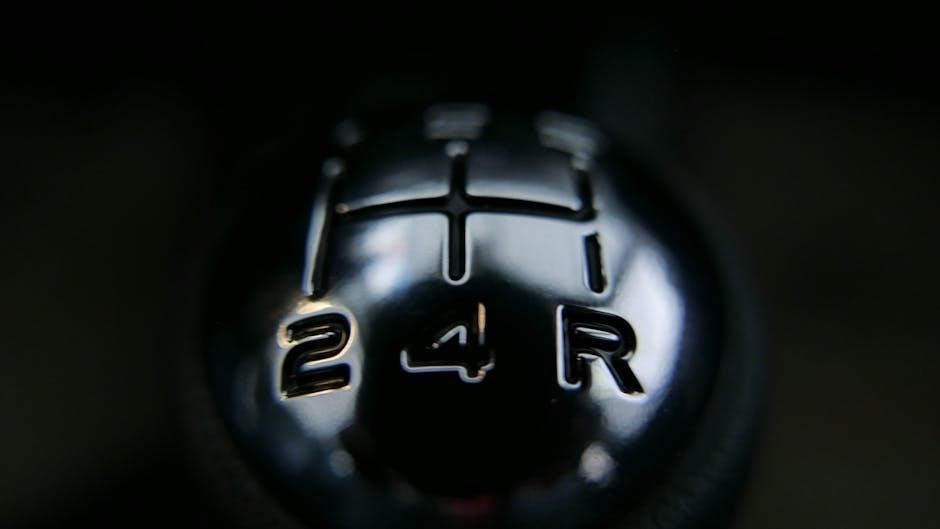A bad manual transmission often exhibits noticeable issues. Difficulty shifting gears, grinding noises, and unusual clutch behavior are common signs. Leaks, dashboard warnings, and hard or stuck gears may also indicate problems. Vibrations, clunking sounds, or failure to engage gears can signal internal damage. Addressing these symptoms promptly is crucial to prevent further damage and ensure safe driving.

Difficulty Shifting Gears
One of the most noticeable symptoms of a failing manual transmission is difficulty shifting gears. This can manifest as a hesitation or resistance when trying to move the gearshift into the desired position. Poor coordination between the clutch and accelerator, or improper shifting techniques, can exacerbate this issue. Over time, consistent difficulty shifting may lead to grinding noises or even stuck gears. If the problem persists, it could indicate worn-out synchronizers or damaged gear teeth, which are critical components of the transmission. Ignoring this symptom can result in further damage, such as chipped gears or a complete failure to engage gears. Regular maintenance and proper driving habits are essential to prevent such issues. Addressing difficulty shifting gears early on can save time and money by avoiding costly repairs down the road;
- Poor coordination between clutch and accelerator.
- Worn-out synchronizers or damaged gear teeth.
- Grinding noises or stuck gears.
Grinding Gears
Grinding gears is a clear indicator of a manual transmission problem. This occurs when the gear teeth fail to mesh properly, creating a loud, unpleasant noise during shifting. Grinding can happen when the clutch is not fully disengaged or if the synchronizers are worn out. Over time, this can lead to significant damage, including chipped or stripped gear teeth. Regular maintenance, such as checking transmission fluid levels and ensuring proper clutch operation, can help prevent this issue. If grinding persists, it may be necessary to replace damaged components to avoid further complications. Ignoring this symptom can result in more severe problems, such as complete gear failure, which would require costly repairs. Addressing grinding gears promptly is essential for maintaining the health of your manual transmission.
- Loud noise during gear shifts.
- Clutch not fully disengaged.
- Worn-out synchronizers.

Unusual Noises
Unusual noises are a common symptom of a failing manual transmission. These noises can vary and may include clunking, whirring, or humming sounds. Clunking noises often occur when shifting gears and can indicate worn or damaged gear teeth or bearings. Whirring or humming noises may suggest issues with the transmission bearings or gear shafts. These sounds can be more pronounced during acceleration or when shifting between specific gears. Ignoring these noises can lead to further damage, as they often indicate internal wear or misalignment. Regular inspections and maintenance can help identify the source of these noises early on, preventing more costly repairs down the line.
- Clunking sounds during gear shifts.
- Whirring or humming noises while driving.
- Damaged gear teeth or bearings.
- Worn-out transmission components.
Clutch Issues
Clutch problems are a common indicator of a failing manual transmission. A slipping or dragging clutch can make shifting gears difficult and may cause the engine to stall. If the clutch pedal feels spongy or requires excessive force to press, it may indicate worn-out clutch components. Additionally, if the clutch doesn’t disengage properly, it can cause grinding noises when shifting gears. Over time, improper use or wear can lead to the clutch failing to engage gears smoothly, resulting in poor acceleration and control. Regular inspection of the clutch and pressure plate is essential to identify these issues early and avoid costly repairs. Ignoring clutch problems can lead to further damage, making it crucial to address them promptly.
- Slipping or dragging clutch.
- Spongy or stiff clutch pedal.
- Difficulty engaging gears.
- Grinding noises during shifts.
Leaking Transmission Fluid
Leaking transmission fluid is a clear sign of a manual transmission issue. Over time, seals and gaskets within the transmission can wear out, leading to fluid leaks. These leaks often appear as puddles under the car, especially after parking for an extended period. Low transmission fluid levels can cause inadequate lubrication, leading to poor shifting and potential damage to internal components. In some cases, the leak may be visible around the clutch housing, input shaft, or drain plug. Ignoring these leaks can result in contamination of the fluid, which may cause further degradation of the transmission. It’s important to inspect the transmission pan and surrounding areas regularly for any signs of moisture or drips. Addressing leaks promptly can prevent more severe damage and costly repairs down the line.
- Puddles of fluid under the vehicle.
- Low transmission fluid levels.
- Visible leaks around seals or gaskets.
- Contaminated or discolored fluid.
Dashboard Warning Lights

Modern vehicles are equipped with sophisticated systems that monitor transmission health. One of the most noticeable signs of a bad manual transmission is the illumination of dashboard warning lights. These lights are triggered by sensors detecting abnormal operating conditions, such as erratic gear engagement, unusual fluid pressure, or faulty solenoid operation. The “Check Engine” light is commonly activated when the transmission control module identifies issues like slipping gears or incorrect gear ratios. In some cases, a dedicated “Transmission” light may illuminate, indicating a direct problem with the manual transmission system. These warnings are often accompanied by fault codes stored in the vehicle’s computer, which can be retrieved using diagnostic tools. Ignoring these lights can lead to more severe damage, as the transmission may not be operating within safe parameters. Always check the dashboard for any unusual alerts and consult a professional to diagnose and address the underlying issue promptly.
- Check Engine Light illumination.
- Transmission-specific warning lights.
- Fault codes stored in the vehicle’s computer.
- Erratic or unusual light patterns.
Hard Shifting
Hard shifting is a common symptom of a bad manual transmission, where shifting gears becomes unusually difficult or requires excessive force. This can occur due to worn-out synchronizers, damaged gear teeth, or low transmission fluid levels. When the synchronizers fail to engage properly, the gears may resist moving into place, making shifting feel stiff or labored. In some cases, hard shifting can also be caused by a faulty clutch or misaligned gear components. Over time, this issue can lead to further damage if not addressed, as the constant strain on the transmission can cause gears to wear down more quickly. If you notice that shifting has become consistently difficult or requires more effort than usual, it is important to inspect the transmission and related components to identify the root cause. Ignoring this symptom can result in more severe problems, such as complete gear failure or the need for costly repairs.
- Requires excessive force to shift gears.
- Worn-out synchronizers or gear teeth.
- Low or contaminated transmission fluid.
- Clutch or gear component misalignment.
Stuck Gears
Stuck gears are another common symptom of a failing manual transmission. This occurs when a gear refuses to disengage or engage properly, leaving the transmission temporarily unresponsive. Stuck gears can be caused by worn-out synchronizers, a faulty shifter cable, or debris within the transmission. In some cases, low or contaminated transmission fluid can also contribute to this issue. When gears become stuck, drivers may experience sudden hesitation or resistance when trying to shift, making it difficult to control the vehicle smoothly. If left unaddressed, stuck gears can lead to more severe damage, such as gear teeth breaking or the transmission locking up entirely. It is important to inspect the transmission components, including the shifter mechanism and fluid levels, to identify and resolve the problem promptly. Ignoring stuck gears can result in costly repairs and potential safety hazards while driving.
- Gears refuse to engage or disengage properly.
- Caused by worn synchronizers or a faulty shifter cable.
- Low or dirty transmission fluid can exacerbate the issue.
- May lead to gear teeth damage or transmission lock-up.

Failure to Engage Gears
Failure to engage gears is a concerning symptom of a bad manual transmission. When gears fail to engage, the vehicle may not respond to shifting, leaving it in neutral or causing unexpected shifts. This issue can stem from a variety of sources, including worn-out clutch components, a malfunctioning shifter assembly, or internal damage to the transmission’s gears or bearings. In some cases, low transmission fluid levels or contamination of the fluid can also prevent gears from engaging properly. If the problem persists, it may lead to complete transmission failure, leaving the vehicle inoperable. Early detection is crucial, as addressing the issue promptly can prevent more extensive and costly repairs. Mechanics often inspect the clutch, shifter linkage, and internal transmission components to diagnose the root cause. Regular maintenance, such as checking transmission fluid and inspecting the clutch, can help prevent this issue from arising;
- Gears do not engage, causing lack of control.
- Caused by worn clutch, shifter issues, or internal damage.
- Low or dirty transmission fluid can contribute.
- May result in complete transmission failure if ignored.

Clunking Sounds
Clunking sounds when shifting gears or accelerating are a clear indication of a manual transmission issue. These noises often occur due to internal damage or wear within the transmission components. For instance, worn-out gears, synchronizers, or bearings can produce clunking or knocking sounds during gear changes. Additionally, a loose shifter assembly or damaged shift forks may contribute to such noises. In some cases, a failing clutch or pressure plate can also cause clunking sounds when engaging or disengaging gears. Ignoring these symptoms can lead to further damage, as the internal components may deteriorate over time. If the clunking persists, it could indicate a need for major repairs, such as replacing gear sets or rebuilding the transmission. Regular maintenance, like inspecting the transmission fluid and monitoring gear engagement, can help identify these issues early. Addressing clunking sounds promptly is essential to avoid costly repairs and ensure smooth gear transitions.
- Clunking sounds during shifting or acceleration.
- Caused by worn gears, synchronizers, or bearings.
- Loose shifter components or damaged shift forks.
- Failing clutch or pressure plate.
- Neglecting this can lead to costly transmission damage.
Slipping Gears
Gear slipping is a concerning symptom of a failing manual transmission. This occurs when the gears fail to engage properly, causing the transmission to “slip” out of gear. Drivers may notice that the engine RPM increases without a corresponding increase in speed, a common indication of slipping gears. This issue can arise from worn or damaged synchronizers, which are responsible for ensuring smooth gear transitions. Additionally, low transmission fluid levels or contamination can cause gears to slip, as the fluid is essential for maintaining proper lubrication and pressure within the system. In some cases, a faulty clutch or excessive wear on the gear teeth can also contribute to this problem. Ignoring gear slipping can lead to further damage, such as stripped gears or complete transmission failure. Regular maintenance, including checking transmission fluid levels and inspecting for worn components, can help prevent this issue. Addressing slipping gears promptly is crucial to avoid costly repairs and ensure reliable performance.
- Gears slipping out of place during operation.
- Increased engine RPM without speed increase.
- Caused by worn synchronizers or low fluid levels.
- Contaminated or insufficient transmission fluid.
- Faulty clutch or worn gear teeth.
- Neglecting this can result in severe transmission damage.
Vibrations While Shifting
Vibrations while shifting gears can be a clear indicator of a manual transmission issue. This symptom often occurs due to worn or damaged components within the transmission system. Common causes include worn-out bearings, misaligned gears, or a damaged input shaft. In some cases, a faulty clutch or flywheel can also contribute to vibrations during shifting. Drivers may feel these vibrations through the gearshift or even the entire vehicle, especially when shifting into higher gears or under load. Persistent vibrations can lead to further damage, such as accelerated wear on synchronizers or gear teeth. If left unaddressed, this can result in costly repairs or even complete transmission failure. Regular inspections and maintenance, such as checking for worn bearings or ensuring proper clutch alignment, can help identify and resolve the issue early. Addressing vibrations promptly is essential to maintain smooth shifting and overall vehicle performance.
- Vibrations felt during gear shifts.
- Caused by worn bearings or misaligned gears.
- Damaged input shaft or faulty clutch.
- Persistent vibrations can lead to further damage.
- Regular inspections can prevent costly repairs.

Whirring or Humming Noises
Whirring or humming noises from a manual transmission are often indicative of internal wear or damage. These sounds typically occur during gear shifts or when the transmission is under load. Common causes include worn or damaged bearings, which can produce a high-pitched whirring sound, especially at higher speeds. Additionally, gear teeth that are chipped or worn may create a humming noise as they fail to mesh properly. In some cases, low transmission fluid levels or contamination can also contribute to these noises by reducing lubrication between moving parts. Ignoring these symptoms can lead to further deterioration, such as accelerated wear on synchronizers or gears. Persistent whirring or humming noises should be investigated promptly to avoid costly repairs. Regular maintenance, including checking transmission fluid levels and inspecting bearings, can help identify issues early. Addressing these problems quickly is crucial to ensure the longevity and smooth operation of the manual transmission system.
- High-pitched whirring from worn bearings.
- Humming due to damaged gear teeth.
- Low or contaminated transmission fluid.
- Persistent noises require immediate attention.
- Regular maintenance can prevent further damage.



0 Comments